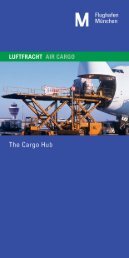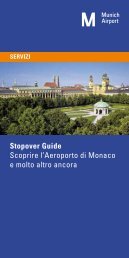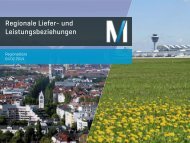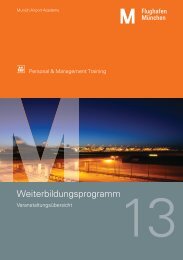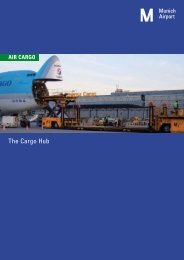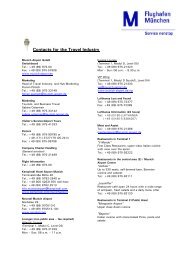"Perspectives 2011" - Sustainability and Annual Report (pdf)
"Perspectives 2011" - Sustainability and Annual Report (pdf)
"Perspectives 2011" - Sustainability and Annual Report (pdf)
You also want an ePaper? Increase the reach of your titles
YUMPU automatically turns print PDFs into web optimized ePapers that Google loves.
Introduction Company profile <strong>and</strong> strategyService portfolio Communication <strong>and</strong> social responsibility) Glossary) Our noise <strong>and</strong> emissionsreports are availablehere:www.munich-airport.com/impacts) Glossary) You can find out moreabout air quality here:www.munich-airport.com/air) www.munich-airport.com/environmentalresearchTogether, the 56 airports that have signed up to thepro gram to reduce their carbon footprints h<strong>and</strong>learound 52 percent of Europe’s passenger traffic. Theircombined efforts currently cut carbon emissions by730,000 tons a year.Air pollutants at prior year levelsA federal government ordinance 1 from August 2010imposes increasingly strict statutory limits on nitrogendioxide (NO 2 ) levels. The limit is currently set at40 micrograms per cubic meter of air, averaged outover the year.In 2011, levels of nitrogen dioxide <strong>and</strong> ) particulatematter at Munich Airport were largely in the low-tomoderaterange <strong>and</strong> broadly the same as in prior years.The mean level of nitrogen dioxide recorded at ourmain measuring station to the east of the airport overthe course of the year was 31 micrograms per cubicmeter, close to the levels of 29–30 micrograms measuredbetween 2007 <strong>and</strong> 2010.Pollutant levels recorded at the main measuring station<strong>Annual</strong> mean levels in μg/m³2009 2010 2011 Limit293031NO 2concentration(nitrogen dioxide)40 40202118PM 10concentration(particulate matter)Our second measuring station, which is on the airport’swest side <strong>and</strong>, like our main station, extremelyclose to the airport, measured levels averaging 28 microgramsper cubic meter, compared to 27–28 microgramsper cubic meter from 2007 to 2010. Althoughthe traffic volume at Munich Airport increased againin 2011, the levels recorded are roughly the same asin previous years.Nitrogen dioxide levels at the airport are similar tothose measured in German towns like Ingolstadt,Bamberg or Würzburg. Levels in rural towns are typicallylower, whereas levels in downtown Munich aresignificantly higher than at the airport. The readingsfrom both measuring stations are retrieved automaticallyevery day over a remote data link <strong>and</strong> are publishedin monthly ) noise <strong>and</strong> emissions reports onthe Internet.The mean annual level of particulate matter (PM 10 )measured during 2011 was 18 micrograms per cubicmeter. In comparison, mean levels between 2007 <strong>and</strong>2010 ranged from 18 to 21 micrograms per cubic me -ter. Levels of other pollutants caused by airport operations<strong>and</strong> aviation are generally very low. We also mon -itor these substances <strong>and</strong> publish the recorded levelsin our monthly noise <strong>and</strong> emissions reports.Honey monitoring shows no impact onqualitySince 2008, Flughafen München GmbH has been testingfor pollutants in honey produced by bee coloniessited at the perimeter fence <strong>and</strong> along arrival <strong>and</strong> departureroutes. We check the airport colonies’ honeyfor traces of substances like heavy metals <strong>and</strong> polycyclicaromatic hydrocarbons (PAHs) that could becaused by air traffic. We additionally test pollen <strong>and</strong>wax samples – the latter because fat-soluble PAHscould accumulate in wax without actually occurringin measurable quantities in the honey. In 2011, themonitoring program confirmed prior years’ findings,which showed that the heavy metals <strong>and</strong> PAHs in thehoney, wax <strong>and</strong> pollen were well below guideline lev -els <strong>and</strong> limits. This indicates that airport operations arenot impacting on the quality of the honey.Biomass-powered heatingMunich Airport covers around 75 percent of its annualheating energy requirements through its own highlyefficient on-site trigeneration plant that combinescooling, heating <strong>and</strong> power generation in a single facility.Barring a minimal amount of energy supplied bypeak boilers, the airport meets the remainder of itsheating needs by purchasing district heat, supplied bya local utility company in Freising via a pipeline.1Thirty-ninth Ordinance on the Implementation of the Federal Pollution ControlAct (Ordinance on Air Quality St<strong>and</strong>ards <strong>and</strong> Emissions Limits), Section 3,dated August 2, 201098




